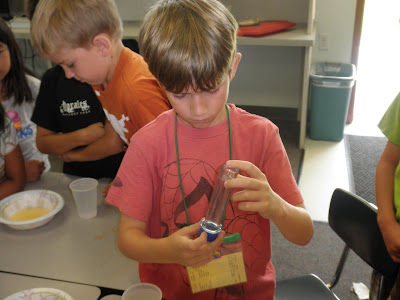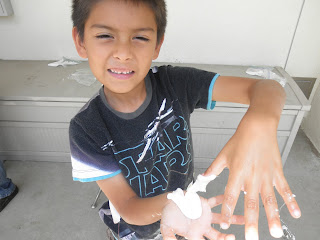tablespoon
teaspoon
1/4 teaspoon
8 ounce measuring cup
a small bowl
Dixie cup
pre-form bottles (test tubes)
a stirrer (skewers)
Salt
water
liquid dish soap
rubbing alcohol
Concept: Your DNA is found in your bllod, cheek cells, skin, and other various parts of your body. The white stringy layer you captured is your own personal DNA. Each string is composed o thousands of DNA molecules all stuck together. There are about 50 trillion DNA cells in your boday. You collected the cells from your cheeks. the dish soap broke down the cells realeasing DNA into the mixture. The salt combined with the DNA, and the DNA clumped together where the water and alcohol layers met.
Procedure: Dissolve 1 tablespoon of salt in 1 cup of water to make a 6% solution of NaC1 (chemical formula for salt NaC1). Salt is made up of sodium and chloride. The Na stands formsodium and the C1 stands for chloried. This will now the called NaC1 solution. Dilute the dish soap by mixing 1 tablespoon of soap with 3 tablespoons of water in your small bowl. This will now be called the detergent solution. Swish 1 tespoon (no tablesppon) of plain water around in your mouth vigorously, for at least 30 seconds. Then, spit it out into the Dixie cup. This will now be called the spit water. Put 1/4 teaspoon of your NaC1 solution into the test tube. Pour your spit water from the Dixie cup into the test tube with the NaC1 solution. Add 1/4 teaspoon of detergent solution to the test tube and place lid on test tube. Gently turn the tube upside down several times. Avoid making any bubbles. Take off the lid and dribble about 1 teaspoon of the rubbing alcohol down the side of the tube into the mixute. Look for the alcohol to form a layer on top of the spit/water/NaC1/detergent mixture. Did a white stringy layer form? Good. Now try and grab it with your stirrer. The gunk you see is your DNA. It contains some proteins, but is mostly your DNA. Scientist have figured out a way to read DNA codes. They can extract DNA from a drop of blood.
Extension: Fingerprinting is also used for identification. Have students use ink to make their fingerprints on paper. Then have students examine their fingerprints and compare to others. What is similar? What is different? What are your fingerprint patterns (arch, tentarch, loop, double loop, pocked loop, whorl, mixed)?
Application to Real World: DNA or deoxyribonucleic acid is a component of the human body. It is the building block for an individual's entire genetic make up. DNA is the same in every cell. DNA is different in every person with the exception of identical twins. DNA can be used to identify a victim and at a crime scene to link or eliminate a suspect. Environmental factors such as heat, sunlight, moisture, bacteria, and mold effect DNA.

















































